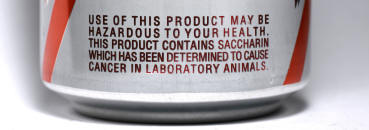Michael Rosenthal
 (8/2015) Artificial Sweeteners, replacing sugar and corn syrup, have become increasingly popular in recent years to bring the enjoyment of sweetness to food and drink while avoiding the negative aspects of sugar Ė calories that add to weight gain, the negative dental effects of
sugar, and the hindering of stabilization of blood sugar levels.
(8/2015) Artificial Sweeteners, replacing sugar and corn syrup, have become increasingly popular in recent years to bring the enjoyment of sweetness to food and drink while avoiding the negative aspects of sugar Ė calories that add to weight gain, the negative dental effects of
sugar, and the hindering of stabilization of blood sugar levels.
The oldest historical sweetener is lead acetate, used as far back as ancient Rome. One does not need a PhD in chemistry to know that use of this is a bad idea! We all now know that lead is a deadly poison.
The earliest artificial sweetener was saccharin, first synthesized in 1879 for a different purpose, and becoming a marketed artificial sweeter in the 1950s. It is 300 to 500 times as sweet as table sugar. I remember my father using saccharin in his coffee as he tried to keep his weight down. A saccharin scare erupted in the 1960s when a connection was
suggested between saccharin use and bladder cancer. Saccharin was banned in Canada as a result of these studies, and consideration of a ban was promoted by the Food and Drug Administration (FDA) in 1977. It was subsequently found that the mechanism that endangered rats was not applicable to humans, and that it is no longer considered a hazard to humans. In 2010 the FDA
concluded that saccharin is no longer a hazard to human health.
Further research and development has produced other sugar substitutes. Stevia is a plant-derived sweetener, whose use has been popular in South America and Japan. In 1908, the FDA labeled its use as "no objection," and its use is common in soft drinks.
Sucralose is a chlorinated sugar about 600 times as sweet as sugar, approved by the FDA in 1998. It is stable when heated, and thus is usable in baking and cooking. Its most common commercial product is marketed as Splenda. The sugar industry mounted a case against Splenda partially based on a marketing slogan. No legitimate safety concerns have been
mounted against this additive.
Cyclamate was banned in the United States in 1969 by the FDA after lab tests on rats indicated that large amounts might produce bladder cancer. Cyclamate is still used in other parts of the world, including the United Kingdom and Russia.
Probably the most popular of the artificial sweeteners today is aspartame. Aspartame was discovered in 1965, whose sweetness is reputed to have been discovered by accident when a drug researcher in American industry licked his finger! It is about 200 times as sweet as sugar and has a broad range of product uses, but because it breaks down at high
temperature it cannot be used in cooking or baking. It is very common in soft drinks, and very small amounts are needed to produce sweetness.
Because of its effectiveness and extensive use, a great deal of study has been carried out as to its safety. There have been claims against its safety, but reviews by disinterested parties and by over 100 regulatory government regulatory agencies in many countries have found aspartame at current levels of use safe for human consumption. At this point
in my writing I examined the information on my can of diet soda and on my coffee sweetener. Both contain aspartame.
The most commonly used artificial sweeteners used in the United States are saccharin, aspartame, and sucralose. There are a few other sweeteners approved by the FDA: neotame, acesulfame potassium, and advantame, a total of seven approved sugar substitutes.
You may have noticed that color coding is used on paper packets of sweeteners here in the United States: white indicates sugar, blue is aspartame, pink is saccharin, yellow is sucralose, and green is stevia.
So why not just use sugar? The calories in sugar, whose taste is enjoyed by most (if not all) human beings, adds to weight gain and to blood sugar levels. The former contributes to the growing obesity problem and the latter is a problem to those with diabetes or diabetic tendencies. Dental care is another reason to reduce sugar consumption. Sugar
promotes tooth decay.
Now, letís take a quick look at homeopathy. Homeopathy is a form of alternative medicine created in the late 18th century. It is a pseudoscience that has been proven to be totally ineffective except for the Placebo Effect. Homeopathic preparations are made by diluting over and over a substance in water or alcohol until the concentration is effectively
ZERO! There is absolutely no evidence that homeopathic preparations are effective in any way, which is rather obvious if you have ever studied chemistry, since the medication, after the extensive dilutions, is just solvent. However, in many drug stores or and natural food stores, you will see homeopathic preparations for sale on the shelves.
In 1938, a U.S. Senator from New York named Royal Copeland slipped a provision into the federal Food, Drug, and Cosmetics Act that granted homeopathic remedies an exemption that allows them to be marketed without any proof of safety or effectiveness. This exemption remains in effect today, so homeopathic remedies may be sold in stores. The
justification of this dilution practice is that "water has a memory" of the molecules that were once dissolved in it. This is, of course, scientific nonsense!
In April of this year, the FDA held two days of public hearings on homeopathic treatment, in which testimony was taken on whether the remedies should be regulated. There have been FDA warnings about specific drugs over the years that have potential danger to the user. Keep alert for future FDA statements!
Michael is former chemistry professor at Mount. St. Marys
Read other articles by Michael Rosenthal